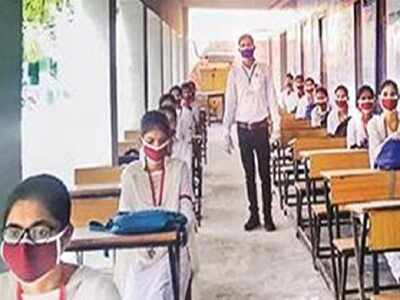
GURGAON: When students return to school, they could find themselves grouped into ‘bubbles’ instead of the familiar red, blue, green and yellow houses.
These protective bubbles, each consisting of groups of around 20 kids, have been introduced at the two government schools in Karnal and Sonipat that have opened for a trial run of Covid-19 safety protocols. The experience of these schools will determine how the bubble system is rolled out across schools in the state.
So, instead of wearing T-shirts or badges of the house colour, students are wearing masks with their assigned bubble colour code and ribbons on their sleeves. They are allowed to interact only with others within that bubble, institutionalising social distancing on campus and altering the school experience completely.
The same colour code has been used on the roll numbers pasted on their desks. No two bubbles can meet or cross paths so that students in one group don’t become contacts of another. Each bubble has to enter and leave the campus together and stays confined within the group during recesses as well.
Officials in the education department said this will make isolation easy in case a student tests positive for Covid-19. Schools in the UK and other European countries had conceived the idea earlier this year after the pandemic broke out.
For the trial run, the two schools have created five distinct student groups and assigned each a colour-coded bubble. “A bubble is an efficient mechanism of creating small groups of pupils and disciplining their activities inside school. It also makes monitoring and tracing their interactions easy. This is a pilot run and we wanted to test the efficacy of this arrangement. The experience in Karnal and Sonipat has been encouraging so far,” a senior education department official.
At the Karnal school, the bubble colours that have been assigned are red, royal blue, dark blue, yellow and green. After the mandatory thermal scanning and sanitisation at the gates, the school is holding separate morning assemblies for each bubble. The classroom is in a lobby to avoid putting students in an enclosed space. The joy of discovering a friend’s tiffin is another casualty of this system – no student is allowed to exchange tiffin, water bottles or books.
Dharampal, principal of the Karnal school (Government Senior Secondary School, Nigdhu), said, “This is the best way of contact-tracing in case somebody tests positive. In such a situation, all the students in that bubble can be isolated and tested. It’s otherwise difficult to segregate students in schools and monitor them, especially at a time when there has to be strict compliance with physical distancing.”
A student at the school this correspondent spoke to said she was happy to be able to see his friends again but nervous at the same time. “I was delighted to see my friends and teachers after six months. Teachers have eased us into the new bubble system. Everything feels new,” said Kajal. Another student of Class 12, who asked not to be named, added, “There is so much happening in the school that we can feel that things aren’t normal. There are so many rules now that it becomes very tiring to remember and abide by them. I also miss my friends as they are in other bubbles.”
These protective bubbles, each consisting of groups of around 20 kids, have been introduced at the two government schools in Karnal and Sonipat that have opened for a trial run of Covid-19 safety protocols. The experience of these schools will determine how the bubble system is rolled out across schools in the state.
So, instead of wearing T-shirts or badges of the house colour, students are wearing masks with their assigned bubble colour code and ribbons on their sleeves. They are allowed to interact only with others within that bubble, institutionalising social distancing on campus and altering the school experience completely.
The same colour code has been used on the roll numbers pasted on their desks. No two bubbles can meet or cross paths so that students in one group don’t become contacts of another. Each bubble has to enter and leave the campus together and stays confined within the group during recesses as well.
Officials in the education department said this will make isolation easy in case a student tests positive for Covid-19. Schools in the UK and other European countries had conceived the idea earlier this year after the pandemic broke out.
For the trial run, the two schools have created five distinct student groups and assigned each a colour-coded bubble. “A bubble is an efficient mechanism of creating small groups of pupils and disciplining their activities inside school. It also makes monitoring and tracing their interactions easy. This is a pilot run and we wanted to test the efficacy of this arrangement. The experience in Karnal and Sonipat has been encouraging so far,” a senior education department official.
At the Karnal school, the bubble colours that have been assigned are red, royal blue, dark blue, yellow and green. After the mandatory thermal scanning and sanitisation at the gates, the school is holding separate morning assemblies for each bubble. The classroom is in a lobby to avoid putting students in an enclosed space. The joy of discovering a friend’s tiffin is another casualty of this system – no student is allowed to exchange tiffin, water bottles or books.
Dharampal, principal of the Karnal school (Government Senior Secondary School, Nigdhu), said, “This is the best way of contact-tracing in case somebody tests positive. In such a situation, all the students in that bubble can be isolated and tested. It’s otherwise difficult to segregate students in schools and monitor them, especially at a time when there has to be strict compliance with physical distancing.”
A student at the school this correspondent spoke to said she was happy to be able to see his friends again but nervous at the same time. “I was delighted to see my friends and teachers after six months. Teachers have eased us into the new bubble system. Everything feels new,” said Kajal. Another student of Class 12, who asked not to be named, added, “There is so much happening in the school that we can feel that things aren’t normal. There are so many rules now that it becomes very tiring to remember and abide by them. I also miss my friends as they are in other bubbles.”
Download
The Times of India News App for Latest India News

Coronavirus outbreak
Trending Topics
LATEST VIDEOS
India
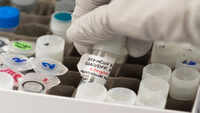 Covid-19: Novavax, Serum Institute aims to produce 2 billion vaccine doses
Covid-19: Novavax, Serum Institute aims to produce 2 billion vaccine doses 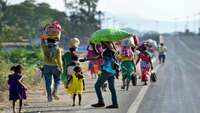 'Panic due to fake news' led to migrant exodus during Covid-19 lockdown: Govt
'Panic due to fake news' led to migrant exodus during Covid-19 lockdown: Govt 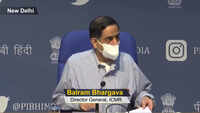 Serum Institute will start phase-III trials after clearances: ICMR on COVID vaccine
Serum Institute will start phase-III trials after clearances: ICMR on COVID vaccine 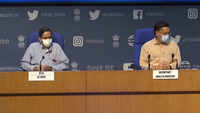 COVID-19: No shortage of oxygen in country, says Health Ministry
COVID-19: No shortage of oxygen in country, says Health Ministry 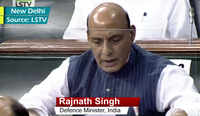 India inflicted heavy casualties on Chinese troops in Galwan: Rajnath Singh in LS
India inflicted heavy casualties on Chinese troops in Galwan: Rajnath Singh in LS 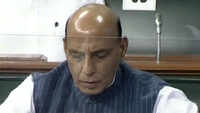 India-China border issue remains unresolved: Defence Minister in Lok Sabha
India-China border issue remains unresolved: Defence Minister in Lok Sabha
More from TOI
Navbharat Times
Featured Today in Travel
Quick Links
Coronavirus in MumbaiCoronavirus in KolkataCoronavirus in HyderabadCoronavirus in DelhiCoronavirus in BangaloreCoronavirus symptomsCoronavirus in IndiaWhat is CoronavirusCoronavirus NewsSolar EclipseNPRWhat is NRCCAB BillCAB and NRCRTI BillPodcast newsLok SabhaShiv SenaYSRCPCongressBJP newsUIDAIIndian ArmyISRO newsSupreme Court
Get the app



